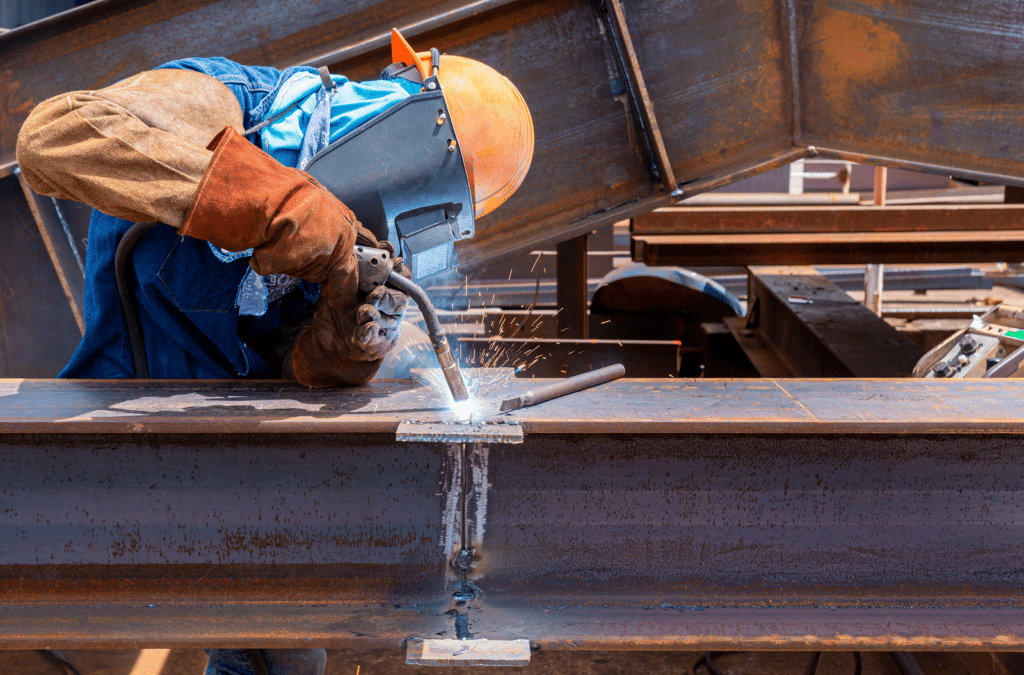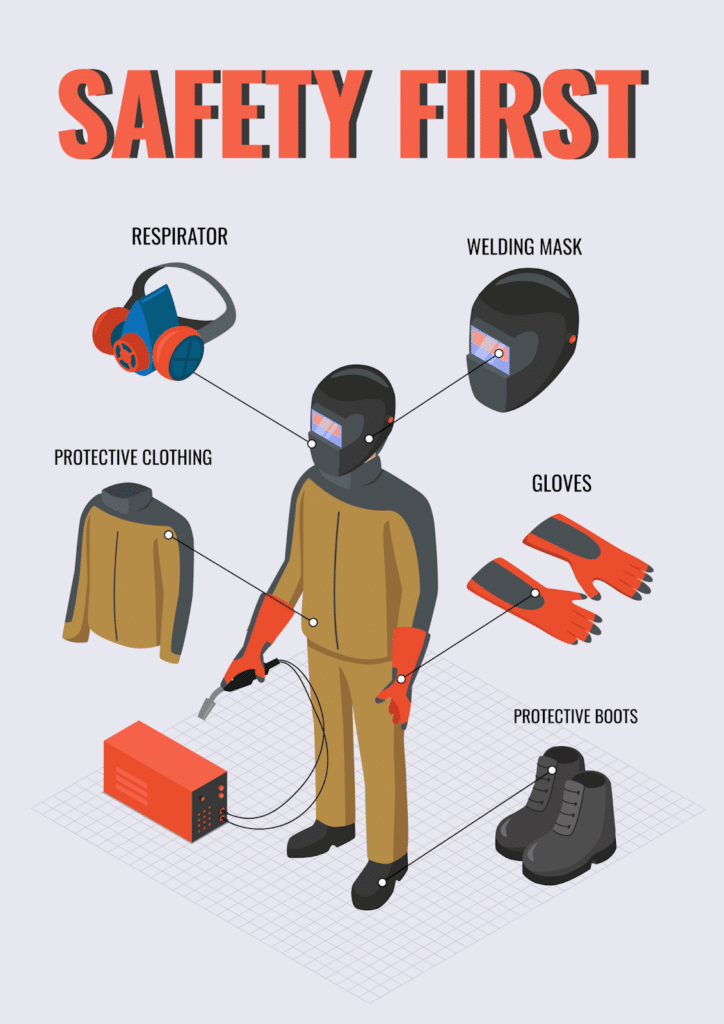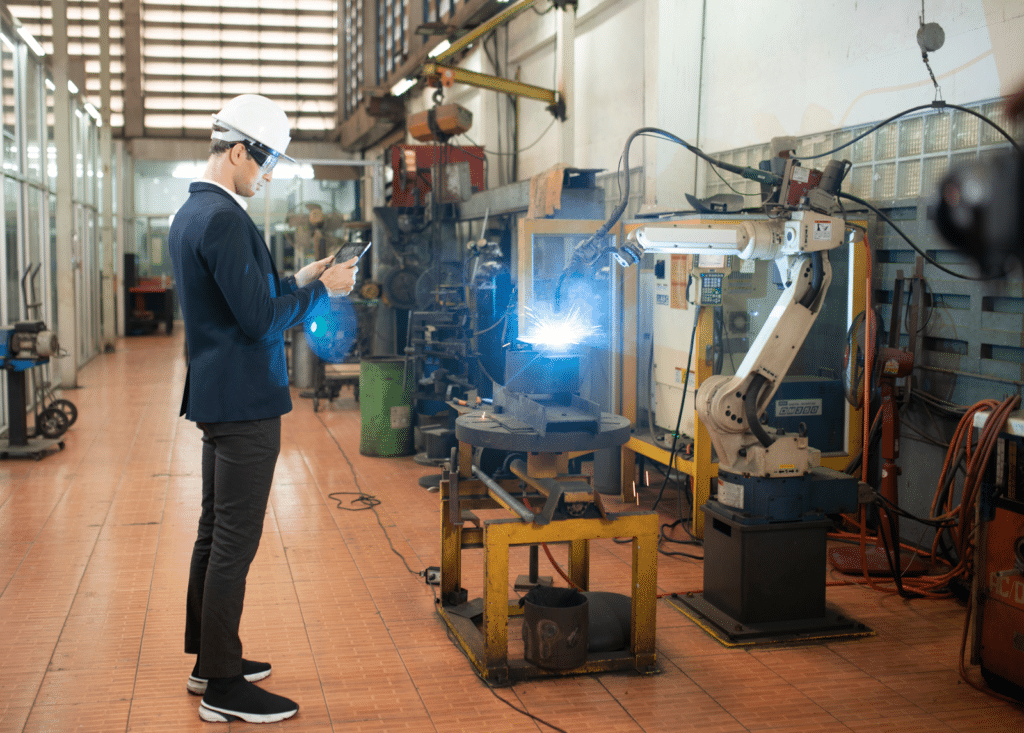Welding is a process of joining two or more metal pieces together using heat, pressure, or both. This technique has been used for centuries and has become an essential part of modern industrial applications. Welding has been critical in the development of infrastructure, transportation, manufacturing, and many other industries.
The importance of welding in industries cannot be overstated. It has revolutionized the way we build and construct things. From bridges to buildings, automobiles to aircraft, welding plays a crucial role in producing and maintaining these structures. In the manufacturing industry, welding is used to assemble complex machinery and fabricate intricate parts that would be impossible to produce through other means.
If you’re thinking about pursuing a career as a welder, it’s important to identify the area you’d like to specialize in. There are over 30 welding types, which are typically divided into four main types.
Table of Contents
4 Main Types of Welding Processes
While there are several types of welding processes, such as – Arc welding, Gas welding, Resistance welding, Solid-state welding, Laser beam welding, Electron beam welding, Atomic hydrogen welding, Submerged arc welding, Plasma arc welding, Friction welding, Ultrasonic welding, and Explosive welding, the four main types of welding are:
- Gas Metal Arc Welding (GMAW/MIG)
- Gas Tungsten Arc Welding (GTAW/TIG)
- Shielded Metal Arc Welding (SMAW)
- Flux Cored Arc Welding (FCAW)
In this blog, we’ll detail the specifics assigned to each process and highlight their differences.
Gas Metal Arc Welding (GMAW/MIG)

Also known as Metal Inert Gas or MIG welding, this process uses a thin wire as an electrode. The wire heats up as it is fed through the welding instrument and towards the welding site. Shielding gas must be used to protect the weld from contaminants in the air.
Typically, this comes in the form of carbon dioxide, oxygen, argon, or helium. This method is often used to work on metals such as stainless steel, copper, nickel, carbon steel, aluminum, and more. This one is most popular among all the welding processes across the construction and automotive industries.
GMAW is believed to be an easier welding technique to learn, making it a great area of focus for beginning welders. It also calls for minimal cleanup and offers high welding speeds and better control over thinner materials.
Some downsides associated with this welding process revolve around the costs of getting shielding gas and an inability to weld thicker metals or perform vertical or overhead welding.
Gas Tungsten Arc Welding (GTAW/TIG)

This type of welding process, also known as Tungsten Inert Gas or TIG welding, is commonly used to weld together thin and non-ferrous materials like aluminum, copper, lead, or nickel. It’s commonly applied to bicycle or aircraft manufacturing.
Unlike other types of welding processes, TIG welding uses a non-consumable tungsten electrode to produce the weld. You will still need an external gas supply, usually argon or a mix of argon and helium.
This is considered one of the most difficult welding methods to master and produces the most high-quality welds. Because there is only a tiny area between the arc and the area being welded, it takes enormous precision and skill to complete. Welds born of this method are known to be extremely strong.
| Type of Welding | Salient features and Comparisons |
| Gas Metal Arc Welding (GMAW) | · Also known as MIG welding (Metal Inert Gas), it uses a wire electrode and a shielding gas to protect the weld from contamination.· Suitable for welding thin and thick metal sections with high-speed production rates and good weld quality.· It offers good control over the welding process and is relatively easy to learn. |
| Gas Tungsten Arc Welding (GTAW) | · Also known as TIG welding (Tungsten Inert Gas), it uses a tungsten electrode and a shielding gas to protect the weld from contamination.· Suitable for welding various metals and alloys, including thin sections and exotic metals like titanium.· It offers excellent weld quality and precise control over the welding process.· Requires a high degree of skill and experience to perform. |
| Shielded Metal Arc Welding (SMAW) | · Also known as stick welding, it uses a consumable electrode coated with flux to protect the weld from contamination.· Suitable for welding a variety of metals and alloys, including thick sections and dirty or rusted surfaces.· Offers good portability and versatility but produces lower-quality welds compared to other methods.· Relatively easy to learn and is commonly used in field applications. |
| Flux Cored Arc Welding (FCAW) | · It uses a continuously fed wire electrode that contains a flux core to protect the weld from contamination.· Suitable for welding thick sections and for outdoor applications where wind and drafts can affect the shielding gas in other methods.· It offers good penetration and high deposition rates but produces lower-quality welds compared to other methods.· Relatively easy to learn and is commonly used in construction and shipbuilding applications. |
Shielded Metal Arc Welding (SMAW)

This type of arc welding process relies on a manual technique using a consumable electrode coated in flux. This method tends to be most popular among home-shop welders. This process is also more informally known as stick welding.
The nickname references the electrode used to weld the metal, which comes in the form of a “stick.” Because SMAW requires minimal equipment, it’s one of the most low-cost processes. This type of welding does not require shielding gas and can be performed outdoors in the wind or rain. It also works well on dirt and rusty materials. That said, downsides do exist.
Stick welds don’t typically produce the best quality products. They are prone to porosity, cracks, and shallow penetration. In general, stick welds are less durable than other types of welding.
Flux Cored Arc Welding (FCAW)

Similar to MIG welding, FCAW revolves around a continuous wire feed process. There are two separate processes associated with FCAW. One involves the use of shielding gas, while the other relies on self-shielding agents produced when fluxing agents decompose within the wire.
This type of welding is known for being inexpensive and easy to learn. Much like the MIG welding process, it’s a great way for beginning welders to kick off their careers in the field.
It also allows welders to work outdoors (windy conditions won’t affect the weld). The semi-automatic arc provides high welding speed and portability, making it a popular process to employ on construction projects.
-
Apply for a welding degree at NEIT!
Loading…
/**/
Choosing the Right Welding Process

Choosing the right welding process can be critical to the success of your project. Here are the factors to consider when selecting a welding process and a comparison of the four different welding processes based on those factors:
Material to be Welded
Different welding processes work better on different types of materials. For example, GTAW is suitable for welding exotic metals like titanium, whereas FCAW is better suited for thicker, more robust materials.
- GMAW: Works well on mild and low alloy steels, aluminum, and stainless steel.
- GTAW: Suitable for welding aluminum, stainless steel, and other exotic metals.
- SMAW: Works on various metals and alloys, including iron, steel, stainless steel, and cast iron.
- Flux Cored Arc Welding: Suitable for welding thick materials and dirty or rusty surfaces.
Welding Position
Different welding processes are better suited for welding in different positions. For example, SMAW is suitable for welding in any position, whereas GMAW is better suited for flat and horizontal welding.
- GMAW: Best suited for flat and horizontal welding positions.
- GTAW: Suitable for welding in all positions but most commonly used for flat and horizontal welding.
- SMAW: Can be used in any position, including overhead and vertical.
- Flux Cored Arc Welding: Suitable for flat and horizontal welding positions.
Welding Speed
Welding speed can affect the production rate and the cost of the project. For example, GMAW has a high welding speed, whereas GTAW has a slower welding speed.
- GMAW: Has a high welding speed, making it suitable for high production rates.
- GTAW: Has a slower welding speed than GMAW.
- SMAW: Has a slower welding speed than GMAW and GTAW.
- Flux Cored Arc Welding: Has a high deposition rate, making it suitable for high production rates.
Welding Quality
The quality of the weld is an essential factor to consider, as it affects the durability and safety of the finished product. For example, GTAW produces high-quality welds, whereas FCAW produces lower-quality welds.
- Gas Metal Arc Welding: Produces high-quality welds with good appearance and penetration.
- Gas Tungsten Arc Welding: Produces high-quality welds with excellent appearance and penetration.
- Shielded Metal Arc Welding: Produces acceptable quality welds but with lower quality than GTAW and GMAW.
- Flux Cored Arc Welding: Produces lower-quality welds compared to other methods.
Cost
Cost is an essential consideration for any project. The cost of welding can vary depending on the process used, equipment required, and labor costs.
- Gas Metal Arc Welding: Has moderate equipment costs and relatively low labor costs.
- Gas Tungsten Arc Welding: Has high equipment costs and higher labor costs due to its complexity.
- Shielded Metal Arc Welding: Has low equipment costs but requires skilled labor, which can increase labor costs.
- Flux Cored Arc Welding: Has moderate equipment costs and relatively low labor costs.
Tips for Choosing the Right Welding Process
- Determine the type of material being welded and its thickness.
- Consider the welding position and production rate requirements.
- Consider the quality requirements of the finished product.
- Factor in the cost of equipment, labor, and consumables.
- Consult with a qualified welding professional.
Welding Safety

Welding involves many potential hazards, including burns, electric shock, fire, explosions, and exposure to toxic fumes and gases. Welding safety is essential to prevent injuries and fatalities in the workplace. It is important to follow proper safety procedures and use appropriate equipment to minimize the risk of accidents and injuries.
Common Welding Hazards
- Burns from contact with hot metal, sparks, or welding equipment.
- Electric shock from welding equipment that is not properly grounded.
- Fire and explosions caused by sparks or hot metal that can ignite flammable materials or gases.
- Toxic fumes and gases, such as carbon monoxide, nitrogen oxides, and ozone, can cause respiratory problems, dizziness, or even death.
- Eye damage caused by exposure to ultraviolet and infrared radiation.
Welding Safety Equipment
- Welding helmet: Provides protection for the eyes, face, and neck from ultraviolet and infrared radiation.
- Welding gloves: Protect hands from heat, sparks, and hot metal.
- Welding jacket: Shields the upper body from heat, sparks, and hot metal.
- Welding respirator: Protects the lungs from inhaling toxic fumes and gases.
- Welding apron: Protects the lower body from heat, sparks, and hot metal.
- Safety glasses or goggles: Provides additional eye protection against flying debris or radiation.
Welding Safety Guidelines
- Conduct a hazard assessment before welding to identify potential hazards.
- Wear appropriate personal protective equipment (PPE) for the job.
- Ensure adequate ventilation to prevent exposure to toxic fumes and gases.
- Keep the work area clean and free from flammable materials.
- Use only well-maintained welding equipment.
- Inspect the work area and equipment regularly to ensure they are in good working condition.
- Use appropriate welding techniques and procedures to minimize the risk of accidents and injuries.
- Train all personnel involved in welding operations on proper safety procedures.
Advancements in Welding Technology

Advancements in welding technology focus on speed, precision, and quality, such as robotic welding and advanced sensors. They have improved productivity, reduced costs, and enhanced weld quality. Future developments will focus on further automation, advanced materials, and environmentally friendly technologies. Advances in materials science will drive the development of new welding techniques for joining dissimilar materials more effectively.
Begin Your Welding Career With the New England Institute of Technology
The associate degree in welding engineering technology at NEIT, one of the best welding schools in the nation, provides the intensive, hands-on experience needed to begin a career as a welding technician.
The program is designed to help students master their welding and pipefitting skills, introduce them to CAD and building design, and teach them how to read blueprints. Additional theory and practice are also included in the curriculum.
Graduates will be prepared for several industry positions, including welding engineering technician, production welder, industrial engineering technician, quality control engineering technician, CADD designer, CADD technician, welding industry salesperson, and materials testing technician.
Students will also be prepared for future certifications through simulated welder qualification tests.
Conclusion
Choosing the right welding process is crucial for successful welding, considering factors like material, position, speed, quality, and cost. Safety is also paramount when welding. Advancements in welding technology have led to more efficient and sustainable processes, with a promising future of new techniques and materials in manufacturing.
START YOUR WELDING CAREER
Earn your degree in Welding Engineering Technology from NEIT and begin your new career path today!
ASSOCIATE'S DEGREE
BACHELOR'S DEGREE
FAQs
What is the difference between arc welding and gas welding?
The main difference between arc welding and gas welding is the heat source used to melt the base metal. In arc welding, an electric arc is created between an electrode and the base metal, which generates intense heat to melt and fuse the metal. In gas welding, a flame is produced by burning a fuel gas with oxygen, and the heat from the flame melts and fuses the metal.
What factors should I consider when choosing a welding process?
When choosing a welding process, you should consider the material to be welded, welding position, welding speed, welding quality, and cost. These factors help determine the best welding process that can produce a successful outcome while being cost-effective.
What safety equipment do I need for welding?
The safety equipment needed for welding includes a welding helmet, protective clothing such as flame-resistant jackets, gloves, and boots, welding goggles or safety glasses, respirators, and ear protection. Additionally, welding in a well-ventilated area and having a fire extinguisher nearby is also essential for welding safety.
How do I become a certified welder?
To become a certified welder, you must complete a welding training program and gain practical experience through apprenticeships or on-the-job training. You then must pass a welding certification test conducted by a certified inspector or organization, which typically involves demonstrating proficiency in the specific welding process and material.
What is the average salary for a welding job?
The average salary for a welding job varies depending on the experience level, location, and industry. However, according to the U.S. Bureau of Labor Statistics, the median annual wage for welders, cutters, and welding machine operators was $47,010 as of May 2021.

